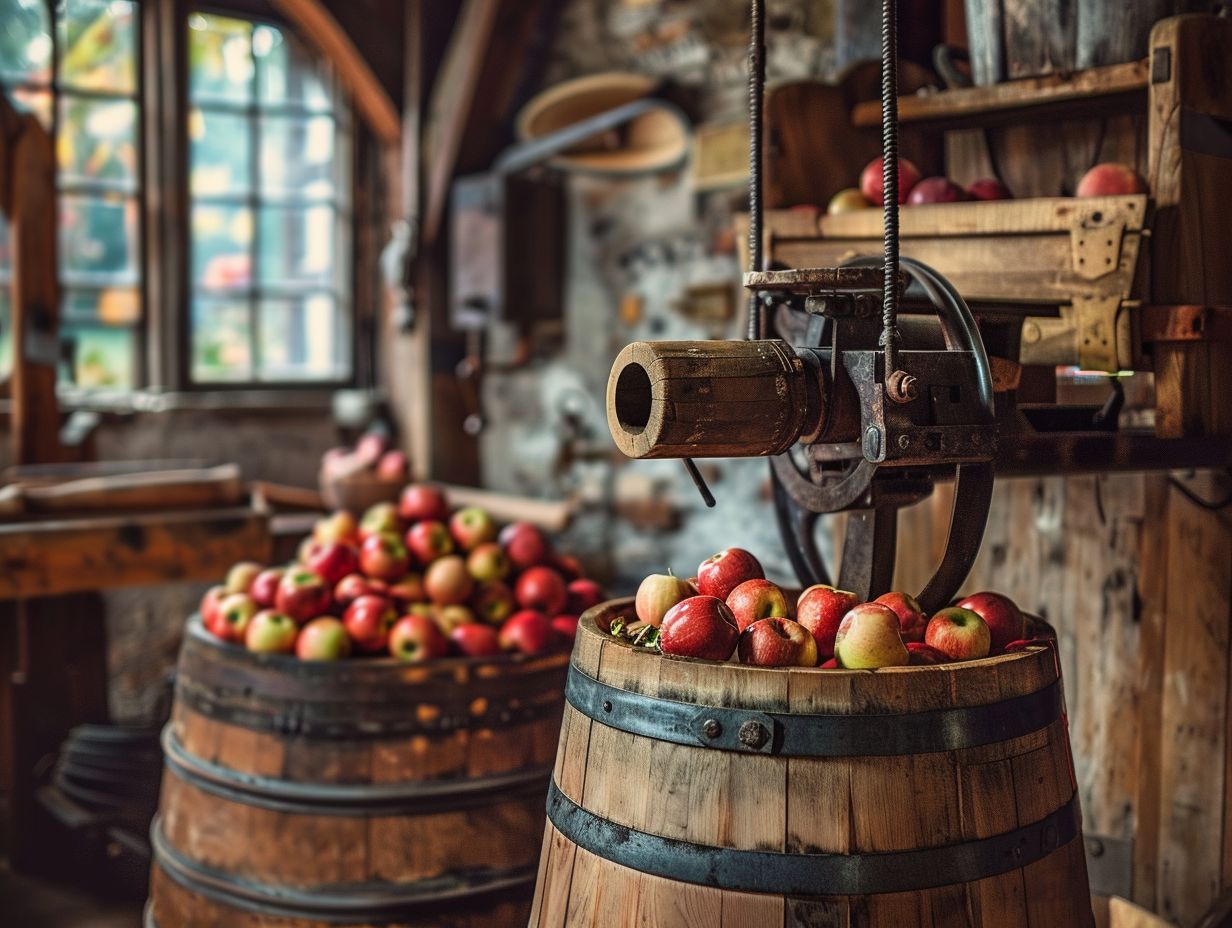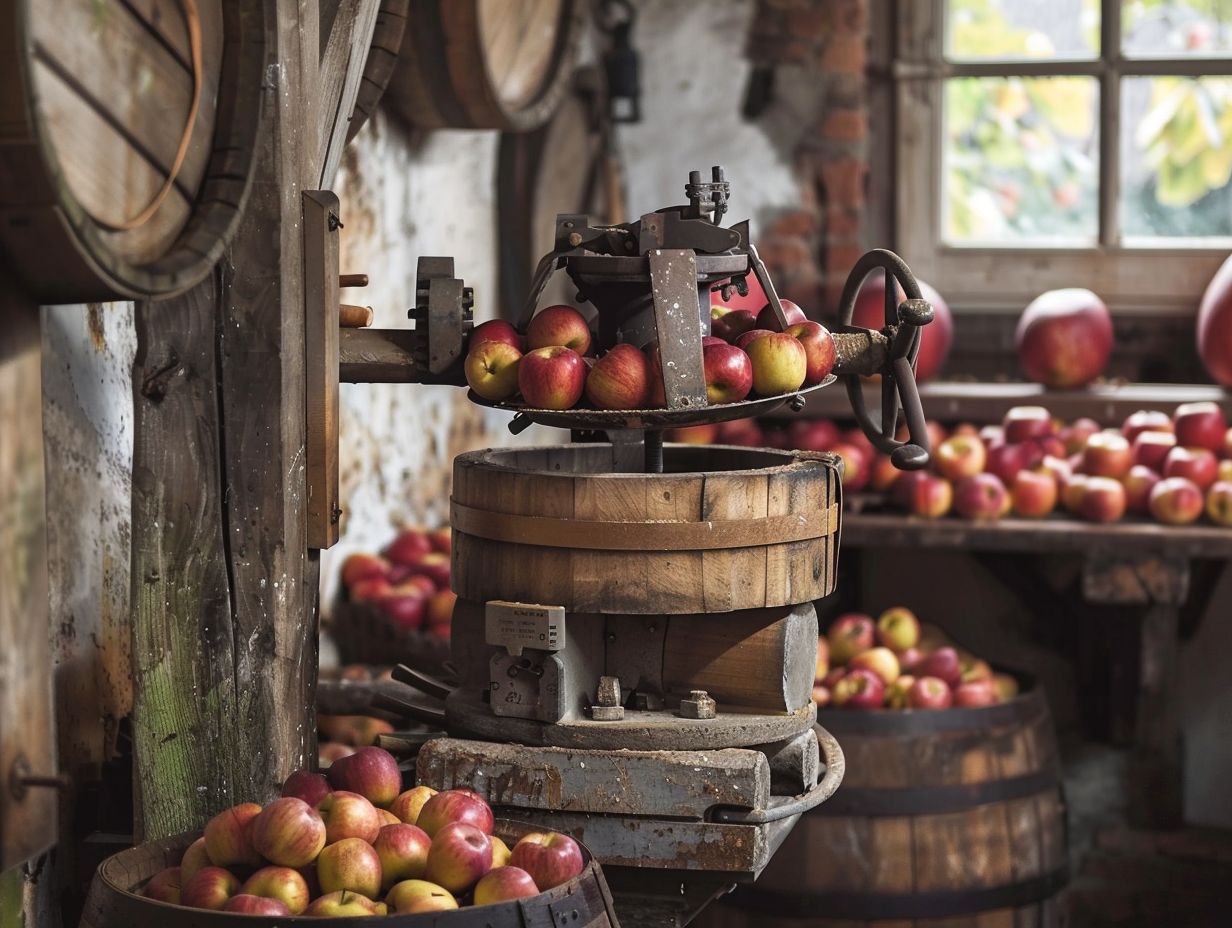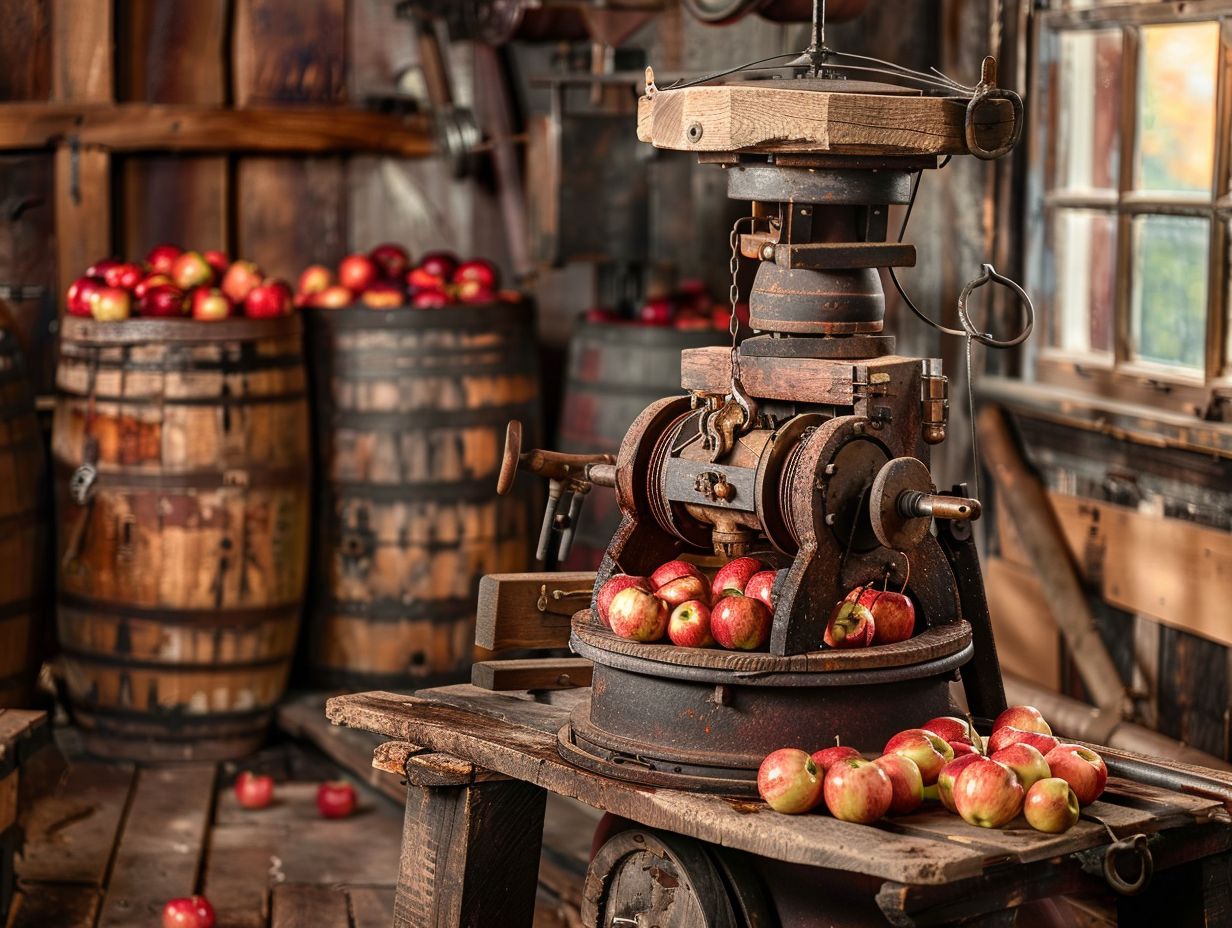Cider making has a rich and fascinating history that dates back centuries. From its origins to its evolution, rise and fall, and eventual revival, the cider making industry has seen many changes over the years.
We explore the first recorded use of cider, where it originated, how it spread across different cultures, and the innovations that shaped its development.
Dive into the modern cider making industry, the different types of cider available today, and the current trends shaping its future. Join us on a journey through the history, evolution, and future of cider making.

Cider making is the craft process of producing an alcoholic beverage known as cider. It involves the fermentation of apple juice pressed from specific apple varieties.
The key techniques in cider making encompass various steps, starting from the careful selection of apple varieties. Different types of apples, such as bittersweet, bittersharp, sweet, and sharp, are blended to achieve a balanced flavor profile.
Once the apples are selected, they are washed, crushed, and pressed to extract the juice. This juice is then subjected to fermentation, where natural yeasts or added yeast cultures convert the sugars into alcohol, resulting in the production of cider. The duration of fermentation and the temperature play crucial roles in determining the final taste and alcohol content of the cider.
The Origins of Cider
The origins of cider making trace back to early history, where it was a traditional practice in orchards with specific apple varieties. Cider making found its way to colonial America, shaping the early techniques of production.
Throughout history, apples have played a crucial role in cider making, with different varieties like bittersweet, bittersharp, sweet, and sharp apples being carefully selected for their unique flavors and sugar content.
In colonial America, cider earned popularity as a staple beverage due to its longer shelf life compared to other alcoholic drinks. Early cider makers employed various techniques such as pressing the apples using hand-operated presses and fermenting the juice in wooden barrels or vats to create the desired taste profiles.
What is the First Recorded Use of Cider?
The first recorded use of cider dates back to ancient times when apples were fermented to create a unique beverage. This early fermentation process marked the beginning of cider making.
In traditional cider making, the choice of apples plays a crucial role in determining the flavor profile of the final product. Different apple varieties, such as bittersweet, bittersharp, sweet, or sharp, are often blended to achieve a balanced taste. The fermentation process involves natural yeasts present on the apple skins or added yeast cultures.
Historical records indicate that cider was a popular drink in regions with abundant apple orchards, where communities would come together to press apples and ferment the juice in large barrels or wooden casks.
Where Did Cider Making Originate?
Cider making originated in regions like England, where orchards with abundant apple trees became the foundation for this craft. It later spread to colonial America, influencing the cultivation of apple trees.
The early stages of cider production relied heavily on the quality and variety of apples grown in these orchards, with different apple cultivars contributing unique flavors to the beverage. The art of cider making was intricately linked to the seasonal rhythms of apple harvests, as the fruits were carefully pressed to extract their juices for fermentation.
Orchards played a crucial role in the sustainability of cider production, providing a steady supply of apples for pressing and processing. This connection between orchards, apple cultivation, and cider making remains a fundamental aspect of the cider industry’s heritage.
The Evolution of Cider Making
The evolution of cider making marked a transition from traditional techniques to more refined craft processes. Orchards played a crucial role in improving production methods over time.
These orchards have not only acted as providers of quality fruit but also as centers for experimentation and innovation. The cultivation of specific apple varieties suited for cider-making has been a key focus in enhancing flavor profiles. In addition, the careful management of orchards to maintain healthy trees has greatly contributed to the consistency and quality of the fruit used in the production process.
As cider makers honed their craft, they began to integrate modern technology and scientific knowledge with traditional methods, leading to the development of sophisticated techniques that have further elevated the art of cider making.
How Did Cider Making Spread Across Different Cultures?
The spread of cider making across different cultures was facilitated by colonial influences and the exchange of techniques among farmers. This cultural diffusion played a significant role in shaping diverse cider-making traditions.
Colonial America, with its diverse mix of settlers from Europe and beyond, became a melting pot for sharing and refining cider-making practices. Farmers exchanged knowledge on apple varieties, fermentation methods, and equipment, leading to the emergence of unique regional styles. As cider gained popularity, it became intertwined with cultural celebrations and social gatherings, solidifying its place in the fabric of communities. From the orchards of England to the apple-growing regions of France, each culture added its own twist to the cider-making process, creating a rich tapestry of traditions that continue to evolve.
What Innovations Were Made in Cider Making?

Over time, innovations in cider making revolutionized the craft, introducing new techniques and refining the brewing process. Orchards became centers of experimentation for cider makers seeking to enhance traditional practices.
These advancements in cider making have not only improved the quality of the final product but also expanded the range of flavors and styles available to consumers. By utilizing modern technologies and scientific knowledge, cider makers have been able to manipulate fermentation processes and ingredient combinations, leading to unique taste profiles. The integration of sustainable practices in orchards has further elevated the industry, emphasizing the importance of environmental stewardship while maintaining the rich heritage of cider making.
The Rise and Fall of Cider Making
The rise of cider making saw a peak in production, fueled by craft techniques and traditional practices. Factors like changing consumer preferences led to a decline in cider making, affecting alcohol content trends.
Craft techniques and traditional practices have long been central to cider production, with artisanal approaches emphasizing quality and flavor. As consumer tastes evolved, a shift towards sweeter, lower-alcohol ciders gained momentum, contrasting the traditional stronger, dryer varieties.
This shift posed challenges for many cider makers, forcing them to adapt their offerings to meet market demands. The resurgence of interest in craft beverages, alongside a renewed appreciation for heritage and artisanal methods, has sparked a revival in the cider industry with a focus on innovation and unique flavor profiles.
When Did Cider Making Reach its Peak?
Cider making reached its peak during a period when craft techniques and traditional methods converged to produce high-quality beverages. This era marked a significant rise in cider production and popularity.
The increase in cider making’s prominence was fueled by the demand for more diverse and flavorful options within the beverage industry. As consumers gravitated towards artisanal and small-batch products, cider makers responded by experimenting with unique fruit blends and fermentation processes. The shift towards organic and sustainable practices also played a role in the heightened quality of ciders produced during this time. These factors, combined with a growing interest in higher alcohol content ciders and innovative production methods, contributed to the golden age of cider making.
What Factors Led to the Decline of Cider Making?
The decline of cider making can be attributed to factors such as the impact of changing consumer preferences, evolving craft techniques, and shifting production methods. These influences altered the landscape of traditional cider making.
As consumer tastes shifted towards lighter and sweeter beverages, the demand for traditional cider experienced a significant decrease. Simultaneously, the rise of craft breweries and wineries offered consumers a wider array of alcoholic options, diverting attention and resources away from cider production. The emergence of innovative craft techniques in brewing and fermentation also played a role in reshaping the cider industry, with traditional methods facing competition from modernized approaches. These shifts forced cider makers to adapt or risk being left behind in an evolving market.
The Revival of Cider Making
The revival of cider making marked a resurgence in craft production and traditional techniques, breathing new life into the industry. Orchards once again became hubs of innovation as cider making experienced a notable comeback.
With consumers increasingly seeking artisanal and locally-sourced products, cider makers embraced the challenge to create unique blends that reflect the terroir of their orchards. The emphasis on quality ingredients and small-batch production methods resonated with enthusiasts looking for authentic flavors and sustainable practices. This renewed focus on craftsmanship not only revitalized the cider industry but also fostered a sense of community amongst cider makers, growers, and aficionados alike. The connection between orchards, craftsmanship, and consumers became the cornerstone of this cider renaissance.
When Did Cider Making Experience a Comeback?
Cider making experienced a significant comeback during a period when craft production and traditional techniques regained popularity. Orchards played a central role in fostering this revival of cider making practices.
The resurgence of cider making can be attributed to a shift in consumer preferences towards more artisanal and locally sourced products. As people began to value authenticity and craftsmanship, they sought out unique beverages that reflected these values, leading to a renewed interest in traditional cider production methods. Orchards, with their rich history and abundance of apple varieties, provided the perfect setting for producers to reconnect with age-old techniques and ingredients, resulting in ciders that possess a depth of flavor and character unlike mass-produced alternatives. This emphasis on quality over quantity has allowed cider makers to stand out in a market saturated with commercial options, appealing to those with a taste for handcrafted beverages.
What Role Did Craft Cider Play in the Revival?

Craft cider played a pivotal role in the revival of cider making, championing traditional techniques and artisanal production methods. This emphasis on craft quality contributed significantly to the resurgence of cider popularity.
By focusing on artisanal production methods and utilizing traditional techniques, craft cider makers brought a fresh perspective to the cider industry. The attention to detail and quality in craft cider production not only elevated the status of cider making but also attracted a new generation of consumers looking for authentic and unique beverages. The resurgence of interest in craft cider also fostered a sense of appreciation for the rich history and heritage of cider production, ultimately leading to a renaissance in the industry.
The Modern Cider Making Industry
The modern cider making industry reflects a blend of traditional craft practices and innovative technologies that have reshaped production methods. Current trends in the industry highlight a mix of heritage techniques and modern approaches.
These trends are evident in the way cider makers are embracing age-old fermentation processes while also leveraging cutting-edge equipment for efficiency and consistency. The integration of traditional barrel-aging methods with modern temperature-controlled tanks showcases a marriage of old-world charm and contemporary precision in cider production. The use of advanced quality control measures, such as automated monitoring systems and data analytics, is revolutionizing how cider is crafted and ensuring a standardized product quality that meets the demands of today’s discerning consumers.
What are the Different Types of Cider Available Today?
Today, the cider making industry offers a diverse range of cider types, including craft varieties and traditional production methods that cater to different consumer preferences.
Craft ciders, often known for their innovative flavor profiles and small-batch production techniques, have been gaining popularity among enthusiasts seeking unique taste experiences. These ciders are typically made with hand-picked fruits and may undergo processes like barrel-aging or wild fermentation to enhance their complexity.
On the other end of the spectrum, traditional ciders, rooted in age-old methods, appeal to connoisseurs looking for classic, time-tested flavors. They are typically crafted using specific apple varieties known for their distinct characteristics and may prioritize techniques like bottle conditioning for a refined taste.
How Has Technology Changed Cider Making?
Technological advancements have transformed cider making by introducing innovative production methods and efficient techniques. The integration of technology has revolutionized the industry’s approach to crafting high-quality beverages.
These advancements have streamlined processes such as fermentation, filtration, and bottling, allowing cider makers to achieve more consistent results with greater precision. Through the use of digital sensors and monitoring systems, producers can closely monitor temperature variations and fermentation stages, ensuring a more controlled and optimized production cycle. The implementation of automated equipment has increased efficiency levels, reducing manual labor and operational costs while maintaining the artisanal essence of craft cider making.
What are the Current Trends in Cider Making?
Current trends in cider making reflect a blend of modern innovations and artisanal craft approaches that emphasize unique flavors and sustainable production methods. The industry is witnessing a shift towards eco-friendly equipment and small-scale production.
This evolution in cider production is driven by the increasing consumer demand for distinctive and eco-conscious beverages. Artisanal cider makers are experimenting with locally sourced ingredients and ancient fermentation techniques to create one-of-a-kind flavors that stand out in a competitive market. The focus on sustainability extends to packaging and distribution practices, with many producers opting for recycled materials and efficient transportation methods to reduce their carbon footprint. By marrying tradition with innovation, the cider industry is paving the way for a more environmentally friendly and flavorful future.
The Future of Cider Making
The future of cider making holds promise for continued innovation and evolution in the industry, with a focus on integrating advanced technologies and sustainable practices to enhance production methods and product quality.
This important shift towards modernization is reshaping traditional cider-making processes by introducing automation and data-driven approaches. Craftsmen are adopting cutting-edge equipment for precision and efficiency, resulting in higher quality control standards and product consistency. Sustainability is at the core of these advancements, with producers exploring eco-friendly packaging solutions and energy-efficient practices. This merger of technology and craft in the cider industry is paving the way for a more environmentally conscious and economically sustainable future.”
What Changes Can We Expect to See in the Cider Making Industry?

The evolving cider making industry is poised to undergo significant changes, including advancements in craft techniques, technological integration, and sustainability practices. These changes will shape the future landscape of cider production.
Craft techniques in cider making are expected to become more innovative and diverse, with cider makers exploring new flavor profiles and experimenting with unique ingredients.
Technology integration is also set to revolutionize production processes, streamlining operations and enhancing product consistency.
Sustainability initiatives will play a pivotal role, pushing for eco-friendly practices such as sourcing local ingredients, reducing waste, and implementing energy-efficient manufacturing methods.
These anticipated changes signify an exciting future for the cider industry, where creativity, efficiency, and environmental consciousness converge.
How Will Climate Change Affect Cider Making?
Climate change poses challenges to the cider making industry, impacting orchard ecosystems, apple cultivation, and production processes. Adapting to these environmental shifts will be crucial for sustaining the craft of cider making.
Without proactive measures, cider makers may face reduced apple yields, changes in fruit quality, and disruptions in the timing of harvests due to irregular weather patterns. Pests and diseases that thrive in altered climatic conditions could pose threats to orchards, requiring innovative pest management strategies. In response, the industry is exploring sustainable practices such as organic farming, regenerative agriculture, and water conservation to mitigate the impact of climate change and ensure the future resilience of cider production.
Frequently Asked Questions
What is the history of cider making?
The history of cider making dates back to ancient civilizations such as the Romans and Greeks. However, it gained popularity in Europe during the Middle Ages and eventually made its way to America with the early colonists.
What was the original purpose of cider making?
The original purpose of cider making was to preserve and consume apples before they spoiled. It was also a safer alternative to drinking water, which often carried diseases at the time.
How was cider made in the past?
In the past, cider was made by pressing apples and fermenting the juice. The apples were often crushed using a traditional cider press and the juice was left to ferment naturally, without the use of added yeast.
When did cider become popular in America?
Cider became popular in America during the Colonial period, as apples were widely available and were used to make a variety of alcoholic beverages.
What caused the decline of cider making in America?
The decline of cider making in America can be attributed to the rise of beer and the increasing popularity of apple cider as a non-alcoholic beverage. Prohibition in the 1920s also greatly impacted the cider industry.
Is cider making still popular today?
Yes, cider making has experienced a resurgence in popularity in recent years. Craft cider makers have emerged, using modern techniques and unique flavor combinations, making cider a popular choice among consumers.





Leave a Reply
You must be logged in to post a comment.